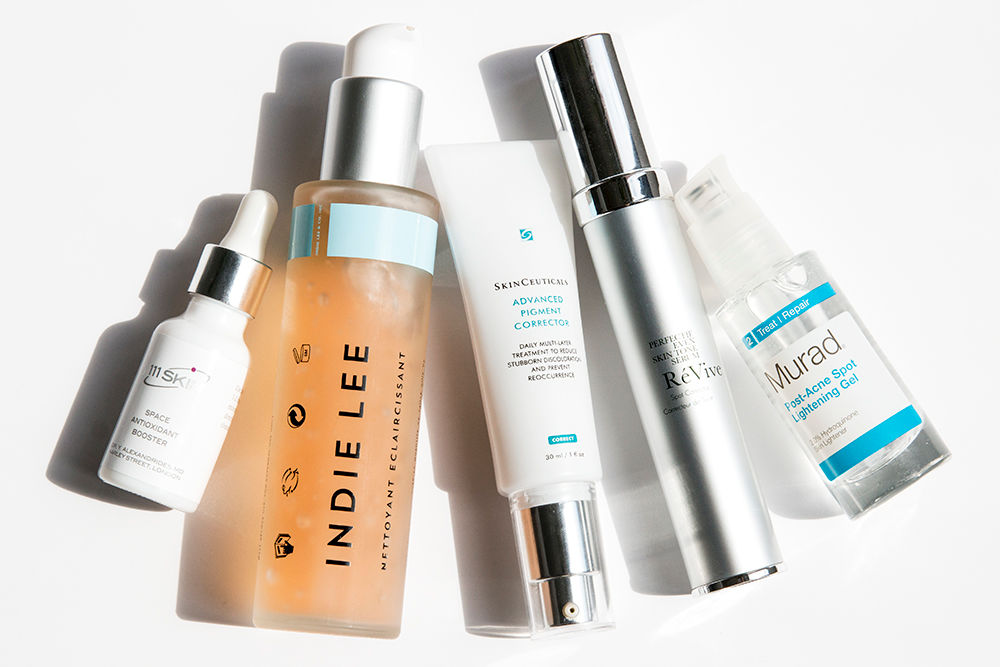Now that we’re living in an age of brightening products (is there a brand that hasn’t come up with some sort of magical lightening or glow-intensifying product in the last year and half?) it seems like high time to discuss at least part of what those products are trying to correct. So settle in kids, let’s talk about hyperpigmentation.
First a definition (or a few): hyperpigmentation is caused when melanin (what gives our hair and skin color) is overproduced in certain spots on the skin, causing them to look darker than your natural skin tone. There are a couple of common causes—age spots on skin that is often exposed to the sun; melasma, often as a result from birth control hormones or pregnancy; and post-inflammatory hyperpigmentation, which happens after a pimple, bug bite, or other trauma to the skin once it heals and leaves a mark behind.
"The most misunderstood idea about hyperpigmentation is that it melts away instead of coming up and out,” says Dayle Breault, of Goddess of Skin and facialist to Tracee Ellis Ross, Lenny Kravitz (plus Zoë and Lisa Bonet) and Britt Morgan Saks. “People think it’s going to fade—which it will do—but it won’t do that without scrubbing away the cells and working on it. And sometimes it’ll get darker before it gets lighter,” As with the night, it seems. When thinking about hyperpigmentation, it's best to break it down into two categories: prevention and treatment. As always, knowledge is power.
Prevention
It goes without saying, but we'll type it anyway: Stop picking at your skin and don't just apply sunscreen—remember to reapply every two hours. Dayle continues that people of color also have to be particularly careful when it comes to hyperpigmentation. “Though black skin would appear thicker and stronger than Caucasian skin, it’s actually much thinner and much more sensitive,” she says. “So you have to be much more careful around heat, with the sun, with any type of extractions, or anything that could make a change in the epidermis.” Men have to be especially careful of ingrown hairs on their face and women with facials. “Even a hot yoga class or some time in a sauna can bring out pigment,” Dayle warns. “And as soon as you put a chemical lightener on your skin, you become a magnet for the sun. You have to wear a hat.” Adding in an antioxidant or vitamin C serum doesn't hurt either—we're fans of the newly released 111Skin Space Antioxidant Booster.
Treatment
First things first, scrub, as Dayle mentioned earlier. It doesn't have to be fancy, and it doesn't have to be chemical. Dayle recommends something physical—her Bonafide Scrub has a mix of granules (made from amber and microdermabrasion crystals) and is safe enough for sensitive skin too. If you’re an ingredient-list reader, be on the lookout for hydroquinone. Often used as a prescription-strength brightener, it’s available over the counter in lower—though still powerful—percentages. “You have to be careful with it,” Dayle says. “You can’t use it if you’re pregnant or trying to get pregnant—and you can only use it for six weeks at a time, and then you have to get off of it. It’s that toxic…but it works.” Murad's Post-Acne Spot Lightening Gel has 2 percent hydroquinone, and while the directions instruct on massaging it over your whole face and neck, Dayle recommends using any product along these lines just as a spot treatment. Otherwise, you'll bleach out the rest of the skin and the spots will continue to look dark in comparison.
As an alternative, SkinCeuticals' Advanced Pigment Corrector is hydroquinone-free (it's got salicylic acid and hydroxyphenoxy propionic acid instead). On the higher end, there's the RéVive Perfectif Even Skin Tone Serum that illuminates the face and is simply a dream to swipe on for $325 a pop. On the natural side of things, Dayle now works with willow bark and licorice root extracts when formulating her products for a natural lightening solution. The Indie Lee Brightening Cleanser capitalizes on strawberry fruit extract and hydrolyzed wheat protein for some moderate complexion control that you don't have worry about concentrating on a specific spot.
For more serious cases, there's chemical peels, lasers, and microneedling (which Dayle calls “the poor man's Fraxel"). They can help renew cells faster and reveal non-hyperpigmented skin. Microneedling in particular also allows product to go deeper in to the skin, as opposed to simply sitting on top. However, these are all best left to the professionals, so consult your dermatologist if considering.
Then there’s the most frustrating, but often very reliable, cure of patience. Spots caused by trauma—say, a badly done home extraction—can go away on their own. You might just have to give it a year—or three.
Photographed by Tom Newton.

